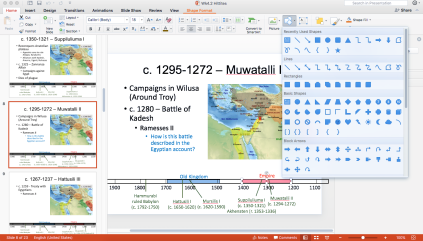Last week in our World history course, my co-teacher asked our students what they found interesting about their reading on Islam, or about what it made them curious. Many of the students were interested in how it related to our other readings, so we set about considering how to help our students make connections among the various lessons. One of our ideas was to create timelines. As with many of our ideas in the course, it ran into the problem that there’s just so much to include in a World history course from 1450-Present. Nevertheless, I added a timeline to the bottom of several of my slides in yesterday’s lecture to help students follow along and make connections.

I used the colored blocks to represent the time periods that we have focused lessons on, and I will add the Industrial Revolution to this timeline when we get there. Even with this arrangement, I found myself limited in how much I could fit on the slides. Indeed, on another slide, instead of “Columbian Exchange starts,” I wrote “Armed trade on the Indian Ocean” because that was the topic being reviewed on that slide.

This issue of so many events was not as problematic when I discussed early Bronze Age Mesopotamia in my Ancient History survey course. On those slides, I summarized the main ideas of the time periods. This, more or less, followed the theme of the discussion accompanying each slide of the lecture. The timeline, I hope, is a way for students to remember our location chronologically, and the developments that we were discussing.
 Yesterday, when I talked about the Hittites in the Ancient History course, I used a similar strategy to the World History presentation. The colored blocks represented larger periods in Hittite history, but this time the “events” were the reigns of the kings who we discussed. On this slide, you’ll notice that Hammurabi is on the timeline for three reasons: (1) Hattusili I created a law code and this is a subtle reminder that Hammurabi had done so earlier, (2) Mursilis I sacked Babylon and ended Hammurabi’s dynasty, and (3) I’m hoping that it helps students remember when the Hittites were in relationship to the other lessons.
Yesterday, when I talked about the Hittites in the Ancient History course, I used a similar strategy to the World History presentation. The colored blocks represented larger periods in Hittite history, but this time the “events” were the reigns of the kings who we discussed. On this slide, you’ll notice that Hammurabi is on the timeline for three reasons: (1) Hattusili I created a law code and this is a subtle reminder that Hammurabi had done so earlier, (2) Mursilis I sacked Babylon and ended Hammurabi’s dynasty, and (3) I’m hoping that it helps students remember when the Hittites were in relationship to the other lessons.

To further help chronologically orient students, I start each Ancient History lecture with a slide like the one to the right that juxtaposes the timelines for the various cultures we have already discussed. I find this particularly helpful because it allows me to remind students that the Hittite Empire was at the same time as the 18th Dynasty. This coevality was relevant later in the lesson as we talked about a few of the Amarna Letters written between the Hittite king Suppiluliuma I and the Egyptian king Akhenaten.
Similarly, this semester I have also frequently been using this slide to help jolt my students’ minds out of the 21st century so that they might more easily comprehend pre-industrial civilizations.

Honestly, I’m not sure how much this has been helping my students make more connections within and among the lessons, or if this is pure idealism. I have, though, noticed that the timelines help me communicate events and connections or summarize some lectures and topics more effectively. For example, in Roman history, one day we discussed Livy’s foundation narrative, and the next we discussed the archaeology of early Rome. I ended the second class by asking how well the two types of evidence aligned, while they looked at a timeline summarizing the evidence we had discussed. It provided an excellent reference for me during the discussion instead of flipping between all my slides. Even if all these timelines are not helping students make those connections, I am very happy with all these timelines, which are inspired by a colleague at Ohio University last semester. Not only have they been useful communication and summation tools, but they have also helped me make connections, better understand the big picture, and make sense of various events and chronologies.
 So, how do I make all these timelines?
So, how do I make all these timelines?
In PowerPoint, I use the “Insert Shape” button which opens the menu of possible shapes, as shown to the right, and the “Format Shape” menu to make the dateline and colored boxes. Then, I add in textboxes and lines for the dates and events. Once I have created one timeline, I simply copy it and paste it to another presentation where I modify it for the new lecture. For example, the timelines for the Hittites and the Age of Empire were copied and adapted (and improved) from my presentation on Early Mesopotamia.
One thought on “Timelines”